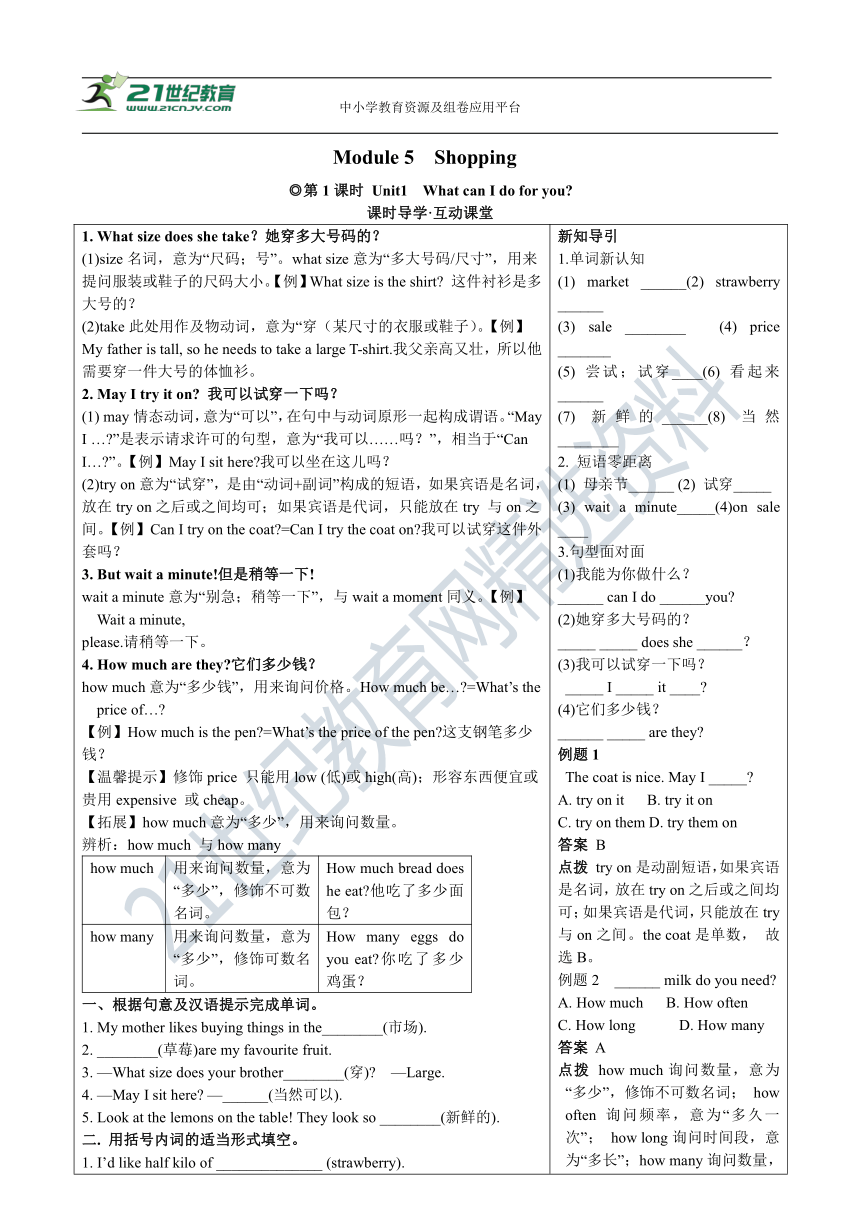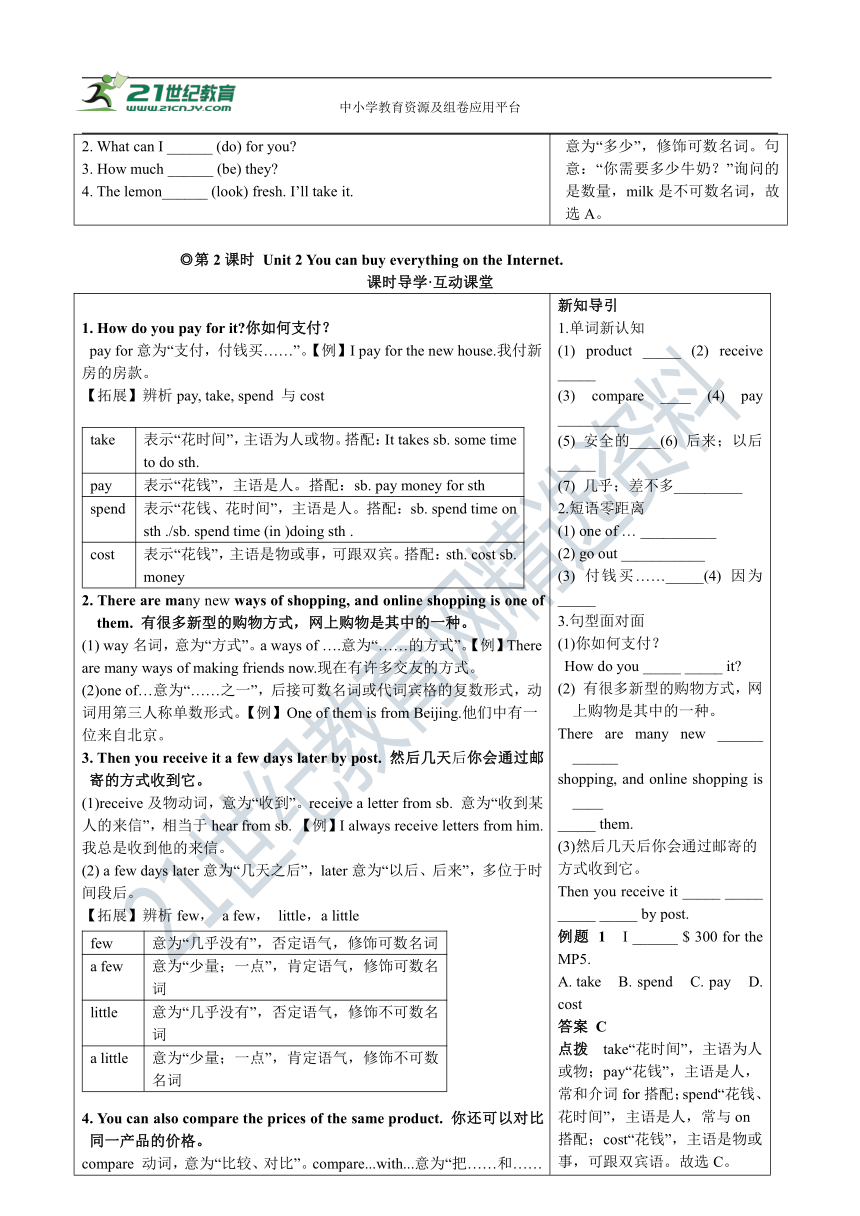Module 5 Shopping 全模块同步学案(含答案)
文档属性
| 名称 | Module 5 Shopping 全模块同步学案(含答案) |

|
|
| 格式 | zip | ||
| 文件大小 | 1.2MB | ||
| 资源类型 | 试卷 | ||
| 版本资源 | 外研版 | ||
| 科目 | 英语 | ||
| 更新时间 | 2019-03-07 21:56:29 | ||
图片预览



文档简介
中小学教育资源及组卷应用平台
Module 5 Shopping
◎第1课时 Unit1 What can I do for you?
课时导学·互动课堂
1. What size does she take?她穿多大号码的?(1)size名词,意为“尺码;号”。what size意为“多大号码/尺寸”,用来提问服装或鞋子的尺码大小。【例】What size is the shirt? 这件衬衫是多大号的? (2)take此处用作及物动词,意为“穿(某尺寸的衣服或鞋子)。【例】My father is tall, so he needs to take a large T-shirt.我父亲高又壮,所以他需要穿一件大号的体恤衫。2. May I try it on? 我可以试穿一下吗? (1) may情态动词,意为“可以”,在句中与动词原形一起构成谓语。“May I …?”是表示请求许可的句型,意为“我可以……吗?”,相当于“Can I…?”。【例】May I sit here?我可以坐在这儿吗? (2)try on意为“试穿”,是由“动词+副词”构成的短语,如果宾语是名词,放在try on之后或之间均可;如果宾语是代词,只能放在try 与on之间。【例】Can I try on the coat?=Can I try the coat on?我可以试穿这件外套吗?3. But wait a minute!但是稍等一下!wait a minute意为“别急;稍等一下”,与wait a moment同义。【例】Wait a minute, please.请稍等一下。 4. How much are they?它们多少钱?how much意为“多少钱”,用来询问价格。How much be…?=What’s the price of…?【例】How much is the pen?=What’s the price of the pen?这支钢笔多少钱?【温馨提示】修饰price 只能用low (低)或high(高);形容东西便宜或贵用expensive 或cheap。【拓展】how much意为“多少”,用来询问数量。辨析:how much 与how many how much用来询问数量,意为“多少”,修饰不可数名词。 How much bread does he eat?他吃了多少面包? how many用来询问数量,意为“多少”,修饰可数名词。 How many eggs do you eat?你吃了多少鸡蛋? 一、根据句意及汉语提示完成单词。 1. My mother likes buying things in the________(市场). 2. ________(草莓)are my favourite fruit. 3. —What size does your brother________(穿)? —Large. 4. —May I sit here? —______(当然可以). 5. Look at the lemons on the table! They look so ________(新鲜的). 二. 用括号内词的适当形式填空。 1. I’d like half kilo of ______________ (strawberry). 2. What can I ______ (do) for you? 3. How much ______ (be) they? 4. The lemon______ (look) fresh. I’ll take it. 新知导引1.单词新认知 (1) market ______(2) strawberry ______ (3) sale ________ (4) price _______ (5) 尝试;试穿____(6) 看起来______ (7) 新鲜的______(8) 当然________ 2. 短语零距离 (1) 母亲节______ (2) 试穿_____ (3) wait a minute_____(4)on sale ____ 3.句型面对面 (1)我能为你做什么? ______ can I do ______you? (2)她穿多大号码的? _____ _____ does she ______? (3)我可以试穿一下吗? _____ I _____ it ____? (4)它们多少钱? ______ _____ are they? 例题1 The coat is nice. May I _____? A. try on it B. try it on C. try on them D. try them on答案 B点拨 try on是动副短语,如果宾语是名词,放在try on之后或之间均可;如果宾语是代词,只能放在try 与on之间。the coat是单数, 故选B。例题2 ______ milk do you need? A. How much B. How often C. How long D. How many答案 A点拨 how much询问数量,意为“多少”,修饰不可数名词; how often 询问频率,意为“多久一次”; how long询问时间段,意为“多长”;how many询问数量,意为“多少”,修饰可数名词。句意:“你需要多少牛奶?”询问的是数量,milk是不可数名词,故选A。
◎第2课时 Unit 2 You can buy everything on the Internet.
课时导学·互动课堂
1. How do you pay for it?你如何支付? pay for意为“支付,付钱买……”。【例】I pay for the new house.我付新房的房款。【拓展】辨析pay, take, spend 与cost take 表示“花时间”,主语为人或物。搭配:It takes sb. some time to do sth. pay表示“花钱”,主语是人。搭配:sb. pay money for sth spend表示“花钱、花时间”,主语是人。搭配:sb. spend time on sth ./sb. spend time (in )doing sth . cost表示“花钱”,主语是物或事,可跟双宾。搭配:sth. cost sb. money 2. There are many new (?http:?/??/?www.21cnjy.com?) ways of shopping, and online shopping is one of them. 有很多新型的购物方式,网上购物是其中的一种。(1) way名词,意为“方式”。a ways of ….意为“……的方式”。【例】There are many ways of making friends now.现在有许多交友的方式。 (2)one of…意为“……之一”,后接可数名词或代词宾格的复数形式,动词用第三人称单数形式。【例】One of them is from Beijing.他们中有一位来自北京。3. Then you receive it a few days later by post. 然后几天后你会通过邮寄的方式收到它。(1)receive及物动词,意为“收到”。receive a letter from sb. 意为“收到某人的来信”,相当于hear from sb. 【例】I always receive letters from him.我总是收到他的来信。 (2) a few days later意为“几天之后”,later意为“以后、后来”,多位于时间段后。【拓展】辨析few, a few, little,a little few意为“几乎没有”,否定语气,修饰可数名词 a few意为“少量;一点”,肯定语气,修饰可数名词 little意为“几乎没有”,否定语气,修饰不可数名词 a little意为“少量;一点”,肯定语气,修饰不可数名词 4. You can also compar (?http:?/??/?www.21cnjy.com?)e the prices of the same product. 你还可以对比同一产品的价格。compare 动词,意为“比较、对比”。compare...with...意为“把……和……比较”。【例】Don’t compare me with other students. 不要把我和其他同学相比较。一、根据句意和汉语提示完成单词。1. The same ______(产品) has different prices in different shops. 2. People like to ______(比较) the prices when they buy something. 3. I often ______(收到) emails from my friends. 4. You can play on the playground, it’s______(安全的). 二、选择正确的词填空。1.It________ (takes/pays) me half an hour to do the job. 2. She is very poor and she has _____(few/ little)money. 3. He has_____(few/ a few)friends here, he feels lonely. 4. You can receive the MP5 a few days__________ (late/later). 新知导引1.单词新认知 (1) product _____ (2) receive _____ (3) compare ____ (4) pay ________ (5) 安全的____(6) 后来;以后_____ (7) 几乎;差不多_________ 2.短语零距离 (1) one of … __________ (2) go out ___________ (3) 付钱买……_____(4) 因为_____ 3.句型面对面 (1)你如何支付? How do you _____ _____ it? (2) 有很多新型的购物方式,网上购物是其中的一种。 There are many new (?http:?/??/?www.21cnjy.com?) ______ ______ shopping, and online shopping is ____ _____ them. (3)然后几天后你会通过邮寄的方式收到它。 Then you receive it _____ _____ _____ _____ by post.例题 1 I ______ $ 300 for the MP5. A. take B. spend C. pay D. cost答案 C点拨 take“花时间”,主语为人或物;pay“花钱”,主语是人,常和介词for搭配;spend“花钱、花时间”,主语是人,常与on搭配;cost“花钱”,主语是物或事,可跟双宾语。故选C。例题 2 The girl in purple is new here, so _____ people know her. A. few B. a few C. little D. a little答案 A点拨 few和 a few 修饰可数名词,little和a little修饰不可数名词。few和little意为“几乎没有”,表否定意义;a few和a little 意为“少量;一点”,表肯定意义。句意:穿紫衣服的女孩是新来的,因此几乎没有人认识她。people是可数名词,故选A。
◎第3课时 Unit 3 Language in use
课时导学·互动课堂
1. …like clothes, toys, computers, things to cook with and so on. ……像衣服、玩具、电脑、做饭用的东西等等。(1)with介词,表示手段或工具,意为“用,以……”。【例】We see with eyes.我们用眼睛看。 (2)and so on意为“等等”。【例】The shop spells clothes, shoes, hats and so on.这家商店卖衣服、鞋、帽子等等。2. What colour does she like?她喜欢什么颜色?本句是what引导的特殊疑问句,What colour+do/does+主语+like? 用于询问某人喜欢什么颜色。【例】--What colour do you like? –Blue.--你喜欢什么颜色?--蓝色。【拓展】特殊疑问句 (1)含义:以特殊疑问词开头,对句中某一成分提问的句子叫特殊疑问句。常用的疑问词有:what, who, whose, which, when, where, how, why等。回答时不用yes或no,而是一个句子或短语。 (2)结构:特殊疑问词 + 一般疑问句。【例】What class are you in?你在几班?【温馨提示】若疑问词在句中作主语或主语的定语,其结构为:疑问词 + 陈述句。 (3)用法:①who对指人名词或代词提问,作宾语时用whom。②what对指物名词、代词或动词短语提出疑问,也可用于星期、日期等。③which对名词前定语提出疑问,而且必须和名词连用。④whose对物主代词和名词所有格提问用。⑤when对具体时间提出疑问。⑥where对具体地点提出疑问。⑦why对表原因的从句提问,常见的有because引导的从句。⑧how对方式或程度、身体状况、天气状况等提出疑问。一、选择正确的单词填空。 1. --_____ is that pretty girl? --She is my sister. 2. --_____ are Jack and Tom? --They are behind you. 3. --_____ do you go to school? --I go to school from Monday to Friday. 4. -- _______do you go to school? –By bike.二、用what time, what color, what day, what填空。1. A: ______ _______ do you go to bed? B: I go to bed at 10:00. 2. A: ______ _______ do you like? B: I like red. 3. A: ______ _______ is today? B: Today is Monday. 4. A: ______ is on the table? B: The apple is on the table. 新知导引1. 短语零距离 (1) half a kilo ____________ (2) and so on __________ (3) 受……的欢迎___________ (4) 目录购物 ___________ 2. 句型面对面 (1) 她喜欢什么颜色? ______ ______ does she like? (2)我要买多少肉呢? _____ ____ meat shall I buy?例题1 --______ will your father come back? –In two days. A. How often B. How soon C. How far D. How long答案B点拨 how often意为“多久一次”,用于提问动作的频率;how soon意为“多久”,用于提问“in +一段时间”; how far意为“多远”,用于提问距离;how long意为“多长”,用于提问时间段或物体的长度。答语是“in+时间段”。故选B。 例题2 --____does John learn Chinese? --She learns it by herself. A. How B. Why C. Where D. Who
答案 A点拨 how 意为“如何,怎样”,询问方式;why意为“为什么”,询问原因;where意为“在哪里”,询问地点;who意为“谁”,询问人。由答语“她自学。”可知此处询问方式。故选A。
模块专题突破
专题讲座·聚焦写作
谈论购物
写作素材
1. online shopping 网上购物
2. a way of… ……的方式
3. on the Internet 在因特网上
4. pay for 支付
5. receive 收到
6. a few days later 几天之后
7. something 某事物;某种东西
典型例题
请以“Online Shopping”为题,写篇短文。
要求:词数不少于60。
Online Shopping
_________________________________________________________________________________________________________________________________________________________________________________________________________________________________________________________________________________
___________________________________________________________________________________________
范文 Online Shopping Do you know about online shopping? It is (1)a new way of shopping. You can buy almost everything on the Internet, and it's very easy. First you can choose (2)something, like mobile phones and (3)pay for it. Then you receive it (4)a few days later by post.Online shopping is changing our way of life. 点评 (1) a way of…意为“……的方式”,后跟名词或动词的-ing形式。 (2) something 意为“某种东西”,常用在肯定句中。 (3)pay for…意为“付……的钱”。 (4) a few days later 意为“几天之后”。“一段时间+later”意为“……之后”。
练习
现在越来越多的人热衷于网上购物,小到书,大到家电都在网上购买。你是如何看待网上购物的呢?你觉得它的优点是什么?根据下面提示,阐述自己的想法。
提示:
1.你几乎可以很容易地在网上购买一切东西;
2.你不必去商店,可以在家选择要买的东西,很方便(convenient);
3. 网上的很多东西要比商店和超市里的要便宜。
要求:1.包括以上要点;
2. 不少于60词。
____________________________________________________________________________________________________________________________________________________________________________________________________________________________________________________________________________________________________________________________________________________________________________________________________________________________________________
Module 5
Unit 1
课前预习练
1.(1)市场(2)草莓(3)降价出售(4)价格(5)try (6)look (7) fresh (8)certainly
2. (1)Mother’s Day (2)try on (3)别急;稍等一会(4) 降价出售
3.(1)What; for (2) What size; take (3)May; try; on(4)How much
课时练
一、1. market 2. Strawberries 3. take 4. certainly 5. fresh
二、1. strawberries 2.do 3. are 4. looks
Unit 2
课前预习练
1.(1)产品(2)收到;接到(3)比较(4)支付;付钱(5)safe (6)almost(7)later
2.(1)……之一(2)外出;游玩(3)pay for (4)because of
3. (1)pay for (2)ways of; one of (3) a few days later
课时练
一、1. product 2. compare 3. receive 4. safe
二、1.takes 2.little 3. few 4.later
Unit 3
课前预习练
1.(1)半千克(2)等等(3)be popular with…(4)catalogue shopping
2. (1)What colour (2)How much
课时练
一、1. Who 2. Where 3. When 4. How
二、1. What time 2. What colour 3. What day 4. What
模块专题突破
专题讲座·聚焦写作
I think online shopping has three advantages. First, you can almost buy everything on the Internet and it’s very easy. Second, you don’t need to go to shops to choose things. It’s convenient to buy things at home. Third, many things are cheaper than those in shops or supermarkets. So I like online shopping.
when, what, who, how, where,
同课章节目录
- Module 1 Lost and found
- Unit 1 Whose bag is this?
- Unit 2 Are they yours?
- Unit 3 Language in use
- Module 2 What can you do ?
- Unit 1 I can play the piano
- Unit 2 I can run really fast
- Unit 3 Language in use
- Module 3 Making plans
- Unit 1 What are you going to do at the weekends?
- Unit 2 We're going to cheer the players.
- Unit 3 Language in use
- Module 4 Life in the future
- Unit 1 Everyone will study at home
- Unit 2 Every family will have a small plane.
- Unit 3 Language in use
- Module 5 Shopping
- Unit 1 What can I do for you?
- Unit 2 You can buy everything on the Internet
- Unit 3 Language in use
- Module 6 Around town
- Unit 1 Could you tell me how to get to the Nationa
- Unit 2 The London Eye is on your right.
- Unit 3 Language in use
- Revision module A
- Module 7 My past life
- Unit 1 I was born in a small village.
- Unit 2 I was born in Quincy.
- Unit 3 Language in use
- Module 8 Story time
- Unit 1 Once upon a time….
- Unit 2 Goldilocks hurried out of the house.
- Unit 3 Language in use
- Module 9 Life history
- Unit 1 He left school and began work at the age of
- Unit 2 He decided to be an actor.
- Unit 3 Language in use
- Module 10 A holiday journey
- Unit 1 What did you do?
- Unit 2 This morning we took a walk.
- Unit 3 Language in use
- Module 11 Body language
- Unit 1 They touch noses!
- Unit 2 Here are some ways to welcome them.
- Unit 3 Language in use
- Module 12 Western music
- Unit 1 It's so beautiful!
- Unit 2 Vienna is the centre of European classical
- Unit 3 Language in use
- Revision module B
